Under its white quilt
the frozen street lies silent
indoors we watch films
===
Last night, as I mentioned, I ventured over to Manhattan, despite the snowstorm, to attend a book launch party for poet and critic Geoffrey Jacques at the Skoto Gallery in Chelsea. Geoffrey, who provided the afterword for Chris Stackhouse's and my book, Seismosis (1913 Press), has just published his first critical study, A Change in the Weather: Modernist Imagination, African-American Imaginary (U. Mass Press, 2009), an exciting and penetrating, carefully historicized and argued exploration of some of the previously underexamined sources of translatlantic Modernism. One of the book's many insights is its discussion of the effects of black urban geographic distribution on Modernist poetics; as Geoffrey and I discussed last night when talking about the figure via whom I first learned about Geoffrey (because of his incisive critique in the Threepenny Review), Wallace Stevens, in addition to all the bright colors, the exotic place names, the unusual terminology, there are also lots of Negroes in his poems. Lots. Geoffrey unpacks this presence, these presences--he said that that letter in the literary journal, which Tom Ellis pointed out to me years ago, was the starting point--across a range of authors and works, while also tracing the influence of other popular and expressive cultural genres and forms such as blackface minstrelsy, ragtime, advertising, vaudeville, and Tin Pan Alley. Geoffrey even got an opportunity to school me a bit more on Stevens as "aesthete," and his relation to Victorian predecessor A. E. Housman. Without question A Change in the Weather is a book worth diving into, as soon as you can, and also check out Geoffrey's collections of poetry, including Just for a Thrill (Wayne State University Press).
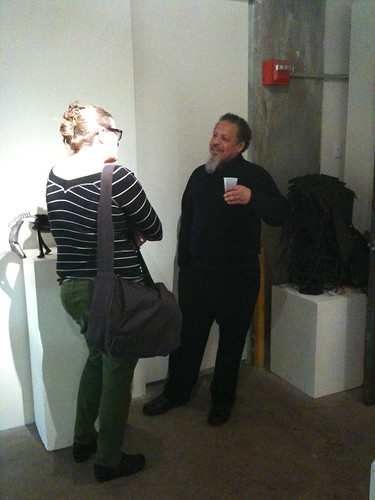
Geoffrey Jacques (at right) and a friend
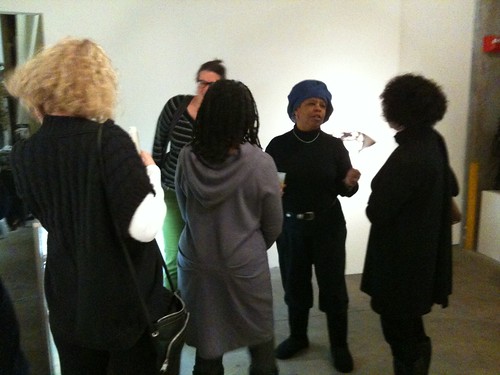
Book party attendees
On display at the gallery were sculptures and 3-D drawings in metal by Nigerian artist Olu Amoda. I was only able to chat with him briefly, but he explained a few things about his work, which he creates from found objects in Lagos, where he has been working since the early 1980s. He also talked about his process to me, noting his desire to go beyond "drawing" as it's traditionally understood, moving from the medium of paper and canvas into metal, various welders taking the place of pen and pencil. Adoma also described one set of 2-3 ft. figures as being inspired by Nobel laureate Wole Soyinka's famous play Death and the Horsemen; he suggested that instead of the usual relationship between humans and props, or sculptures as props, he wanted to animate the usually inanimate. The expressivity of his metal forms definitely gave them a sense of movement, and liveliness.

Olu Amoda
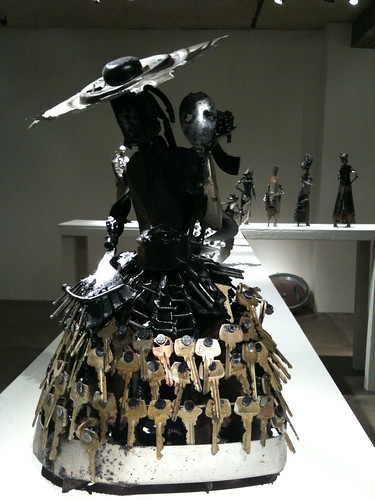
One of Amoda's sculptures, from the Death and the Horseman series
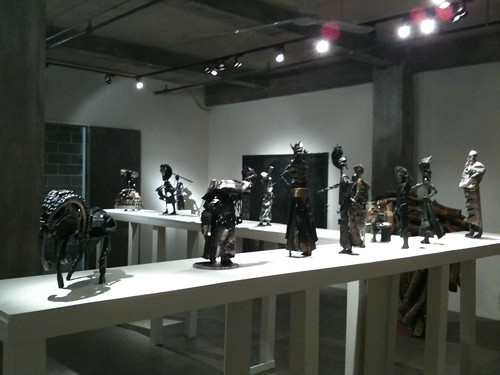
The Death and the Horseman series
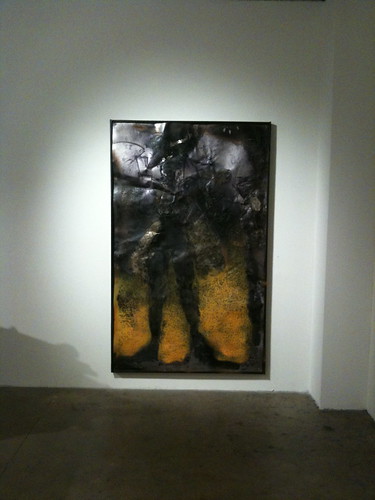
One of Amoda's drawings, on/in metal
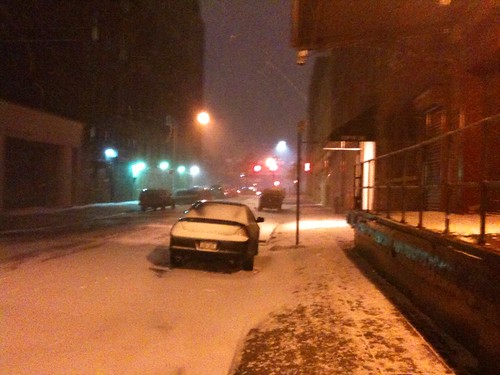
Chelsea street (W. 20th St.), during the snowstorm
===
On another note, I've got so much catching up to do. First, congratulations to Washington, DC's City Council, led by Republican David Catania, for passing a same-sex marriage bill and for having a mayor, Adrian Fenty, willing and eager to sign it. As conservative as Southern-influenced Washington can sometimes be compared to other parts of the East Coast, let alone the rest of the country, but not always. This was a particularly hopeful sign in light of the collapse of the marriage equality push in New York State earlier this month, the horrible reversal in Maine, and the ongoing intransigence of the Obama administration and Democratic-controlled Congress to repeal hateful laws and policies like Don't Ask, Don't Tell (DADT) and the Defense of Marriage Act (DOMA), and to pass the Employment Non-Description Act (ENDA). Now, on this issue at least, DC must become a beacon casting its light north, south, east, and west.
I also have been meaning to note the passing in November of Jeanne-Claude, legendary partner of and co-artist, for over half a century, with the equally legendary Christo. It was their spectacle in orange, in New York's Central Park, the sublime (to me) and crowd-pleasing "The Gates," with which I inaugurated this blog back in February 2005. (Actually Jay Wright and Rainer Rilke came first, but should that be a surprise?) That blogging moment feels like a lifetime ago, but the drama surrounding the installation, and then the anticipation and subsequent experience of heading uptown and walking through the series of sunset-brilliant standards, is quite vivid. That was only one of Jeanne-Claude and Christo's public triumphs; they also famously, or notoriously depending upon your perspective, wrapped an atoll and Berlin's Reichstag building, among many other structures, natural and manmade, in plastic; erected umbrellas in California; and raised an "Iron Curtain" on a Paris street. Christo plans to continue their ongoing projects, and it wasn't until well into their careers that Jeanne-Claude was credited with her central role in their projects, but thankfully she was, and together she and he pushed the boundaries of public and conceptual art and sculpture while also devising new and interesting means of political expression. Jeanne-Claude's vision and savvy, so key to Christo's, will be missed.
Nielsen has announced the immediate closing of media watchdog Editor & Publisher, and, personally more devastatingly to me, Kirkus Reviews. Librarians and bookstores will probably lament the latter shuttering, while quite a few authors, slammed in the pages of Kirkus, may not. I personally had a very positive experience with the publication; it gave Annotations one of its first reviews, a very laudatory one at that, that appeared to set the tone for all the ones that followed in the first months after the book hit the shelves. My publisher was both amazed and pleased beyond belief--or relief, perhaps. But beyond my personal experience, it's important to note that the loss of yet another major book reviewing organ can only be viewed as a loss for contemporary American letters and publishing. As fine as so many of the online review publications are, none has the history or scope of publications like Kirkus. What are we to do, though? Perhaps a not-for-profit is the way to go. Will a consortium of wealthy authors (Tom Clancy? John Grisham? Terry McMillan?) bankroll its establishment? How then to keep it in print? What would a sustainable model look like? These are pressing questions every author should be thinking about.
==
The Senate Democrats are finally set to pass a severely weakened version of health care reform legislation. It's shorn of a public option, of a Medicare buy-in, of a drug reimportation measure, and of several other features that President Barack Obama promised during his 2007-8 campaign; it does, however, have restrictive anti-abortion and anti-immigrant language, weakened subsidies, and a funding mechanism tied not to increased taxes on the rich but on so-called "Cadillac" plans, and, worst of all, the very mandate that Obama decried in Hillary Clinton's and John Edwards' plans. It will thus deliver 30 million new customers, at penalty of fine and under financial duress, to the health insurance, pharmaceutical, hospital, and medical device companies. This is not what Obama and the Democrats promised last year, nor what they were elected to deliver, and yet progressives are being urged--when not being insultingly called "insane" or "batsh*t crazy"--to swallow our desire for a fight and a superior bill, and support this dreck. In the Senate, they'll probably do it, and it'll probably also happen in the House with minimal adjustment, despite Speaker Nancy Pelosi's own promises, meaning this train-wreck a bill will become law. The president, who has cut deals with health care lobbyists (cf. Tom Daschle, among others) and Big PhrMa, are determined to sign whatever crosses his desk, no matter how awful.
One of the few contemporary journalists I trust, Nobel laureate economist and opinion columnist and blogger Paul Krugman, says that this bill will be better than nothing, and can serve as a beginning step in reforming health care, but even he agrees that it could be a lot better. Much better. Journalist Matt Taibbi, however, says, in concert with former DNC chairman and physician Howard Dean, that the Democrats ought to scrap this crap and produce a better bill via reconciliation. But Senate Majority Leader Harry Reid refuses to go this route, and the Washington Village consensus* is that it can't be done. (Why?) So this mess, opposed by all 40 Senate Republicans despite Obama's endless conciliation and machinations--for them to serve as cover?--is probably going to pass. And the Democrats could pay a serious electoral price in 2010.
Ultimately, I think Krugman is right that the longterm effects will be positive even if they don't address some of the key structural problems with our health insurance system (such as the for-profit motive that's a major source of the steadily rising costs), but if Obama keeps screwing up and following Bill Clinton's playbook of moving further to the right and slamming the Left base, we could end up with a GOP Congress and, worse, a real Republican in the White House in 2012. Perhaps Obama and the Democrats will wake up before then instead of reverting, as always, to their neoliberal, corporatist, Third Way default policies. If neither does, Lord help us, because though we know we can live under GOP misrule, the next iteration will only be that much worse.
*Nate Silver also says it'd be difficult, calling reconciliation an "insidious myth." Well okie dokey!









So far, my favorite moment of this whole blizzard was seeing a hapless New Yorker trying to cross Hudson street while the snow was still coming down. A plow had just come through, and he was trying to get over the snowbank this had created when a blast of wind blew his hood off, blinded him with snow, and made his dainty attempt to climb over the snowbank end with him standing in it up to his knees instead. He regained his balance, faced the wind, thrust both fists up into the air and shouted "F**K yeah! I LOVE Chicago!"
ReplyDeleteIt made me laugh, even if this city's Chicago impression is still missing a few months of ice and bitter, face-flaying wind.
Exactly! I wish I'd witnessed that. I don't think most New Yorkers have any idea of what a real Chicago winter, or even a Chi snowstorm, is like.
ReplyDelete